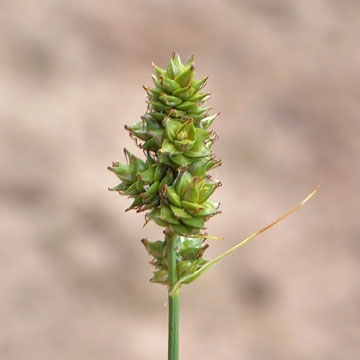

Carex muehlenbergii - (image 1 of 3)
Taxonomy
Family: Cyperaceae
Section Phaestoglochin
Habitat
Dry grasslands or open woods, in sterile or sandy soil.
Associates
Distribution
ME to MN, south to FL, NE, and TX.
Morphology
Tufted perennial; stems slender, stiff and wiry, 20-100 cm, usually much surpassing the leaves; leaves flat, thick, 2-5 mm wide; inflorescence ovoid to cylindric, 2-4 cm; spikes androgynous, ovoid or subglobose, 5-8 mm, crowded, the lower often separated but still overlapping; scales greenish, ovate, acute to acuminate or cuspidate; perigynia 8-20, greenish, 3-4 mm, broadly ovate, planoconvex, 1/2 to 3/4 as wide as long and the body often suborbicular, strongly 5-11-nerved dorsally, nerved or nerveless ventrally, abruptly narrowed to a round-margined beak 1/4 to 1/3 as long as the body.
Notes
Fruiting May to July
Wetland indicator: NA
Typical C. muehlenbergii has pistillate scales 2.5-3.6 mm long and perigynia 3-4.2 mm long, the latter 5-9-veined or veinless ventrally. The possibly less common var. enervis Boott has pistillate scales 2-2.5 mm long and perigynia that are 2.7-3.1 mm long and veinless ventrally.
References
Ball, P.W. and A.A. Reznicek. 2002. Carex, In: Flora of North America Editorial Committee, Eds. Flora of North America North of Mexico. Volume 23. Oxford University Press, New York.
Gleason, Henry A. and A. Cronquist. 1991. Manual of Vascular Plants of
Northeastern United States and Adjacent Canada. Second Ed.
The New York Botanical Garden. Bronx, NY
|
© Michael Hough 2018 |